| Merry Plugmas Getting Started with Plug Building |
|
The Beginners guide to Building Custom Fishing Tackle - Getting Started with Custom Fishing Lure Building. Jigman shows us the steps to build a custom fishing plug by making a Danny Swimming Plug from scratch. Ok, time for a little Christmas step by step. I’m sure a few of the newer guys got lathes or other plug making tools for Christmas. So here is something to play with to get started. Hopefully there is something in here that will be of use to those who have been making plugs for a while too. For those more experienced, feel free to suggest alternative ways to do some of the steps (I don’t mind learning too ). Here I’ll go through the steps to making a Danny plug. The end plug will be 5 inches long and weigh around 1 ½ oz. I’ll be using AYC for the wood, but other woods can also be used. You may have to play with the amount of weight in the plug if you use another wood. Note that in the following photos none of the equipment is turned on (I like my fingers!!). Ok, on to the plug building! 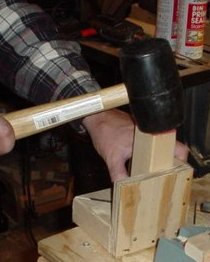 Once you have mounted the plug on the lathe you’ll start with a gouge to knock the corners of the block and round out the blank. The thickest diameter for the finished plug will be 1.1 inches, so make sure to leave the blank a little thicker than this. You can use a set of calipers to check your diameters as you go. Once rounded out, place marks on the blank for the end points (i.e., so you have a 5 inch plug). Next place a mark at 2 ½ inches. This will be the center point of the plug. On a Danny, the center is the thickest part. 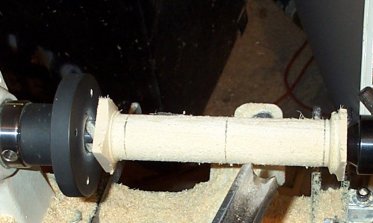 Next, we’ll drop the front of the plug down close to .8 inches. You can rough this out with the gouge or the skew (I’m using a skew here), which ever you feel more comfortable using. You’ll want to taper this back to the center point you marked earlier. 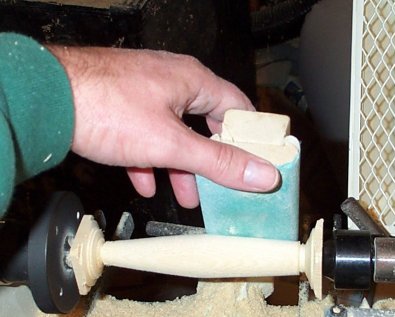 Next, we’ll turn the tail down to .6 inches. Again, you’ll taper this to the center point. At this point, the blank should be close to the final specs (.8 at front, 1.1 center, and .6 inches at the tail). When tapering the front and tail, you can take just the very ends down to the specified dimension, then turn the rest. Alternatively, you can slowly take the whole section down at one time. To make sure everything is even, I’ll use a sanding block to do the rough sanding. Using the block insures that the tapers are even. 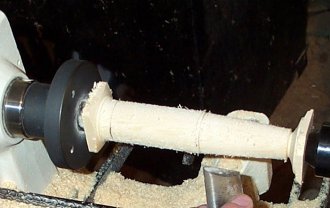 I like a little curve to the body, so I’ll use a piece of sandpaper held between my hands to get this effect. No photo for this as I need two hands to use the sandpaper. I’ll hit it with 80 grit first, then finish up with 180 grit. You can do this on the lathe. With the blank still on the lathe, hold a pencil to the blank to mark the weight, swivel, and eye (if you want an eye on your plug) locations. On this one, the eye is at .85 inches, hook at 1.5 inches, and the weight at 2 ½ inches from the front of the plug. 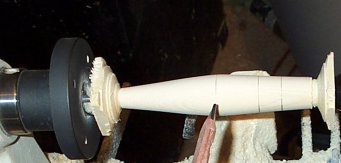 While the square ends are still on the plug, mark the hook, and weight locations. You can do this while the blank sits on a level surface. Looking down the center of the plug, the high spot on the blank will be the center of plug. With the square ends still on, we’ll also cut the lip slot. The lip will be dead center. Mark this with a pencil. I do the lip slot on the bandsaw. To aid in keeping the blank squared, I set up the fence and use a scrap piece of plywood. The plywood sits against the fence and the square ends of the blank line up with the edge of the plywood. A simple, but effective, jig. 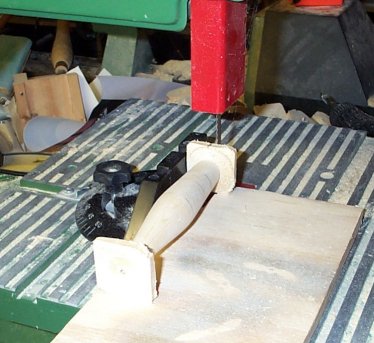 Once the lip slot is cut, you can remove the square end at the front of the blank. Leave the square end on the tail of the blank for now. The next step is to drill the plug for the thru-wire. Mark the front of the blank using the slot on the lip to indicate where the line tie will be. Here I’m using a Lefty 1 lip from NJtackle.com (they have the best lips around). Note that this is the older style lip with two slots in the lip. They now have two versions: one with the upper slot and one with the middle slot. You’ll want to get the lips with the upper slot for this plug. 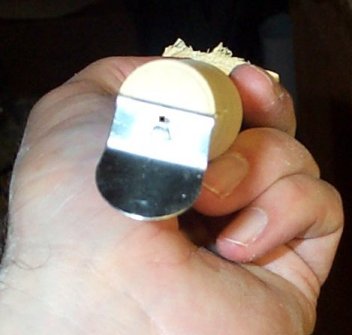 Once marked, I use a drill chuck on the lathe to drill the thru-hole. I drill the plug from both ends using a 1/8 inch brad point bit. A short bit works best for this as it will flex less than a longer bit. I’ll use these as guides and finish up with a longer bit in a hand drill. Again, drill from both ends until the holes meet in the center of the plug. editors note - since this article came out, the general consensus is that it is far safer to drill the thru hole by keeping the body not moving and the bit turning in the lathe. Jigman recommends not to drill as per the original pictures in this thread. Several examples of thru drilling can be found here: http://www.striped-bass.com/Stripertalk/showthread.php?t=39861&highlight=center+drilling 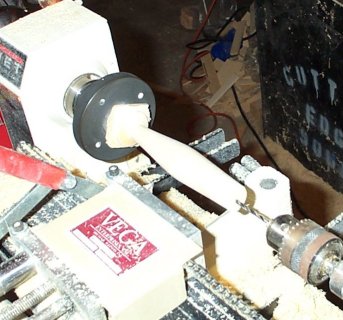 Next, I do the swivel, weight, and eye-holes. I do this on the drill press using a simple jig to keep things lined up. The jig consists of a scrap piece of sheet metal attached to a section of 2x4. The 2 by is attached to another piece of scrap wood. The sheet metal slides into the lip slot on the blank. When placed on the drill press, the blank will be held straight. Drill a 5/16 inch hole, ¼ inch deep for the weight. Drill the hole for the swivel next. I like the eyes just above the center line, so that is how I’ll mark, then drill the holes (3/8 in this case). I use forstner bits for the weight, swivel, and eye holes (yes, that is a brad point bit in the photo, I cheated for the photo ). 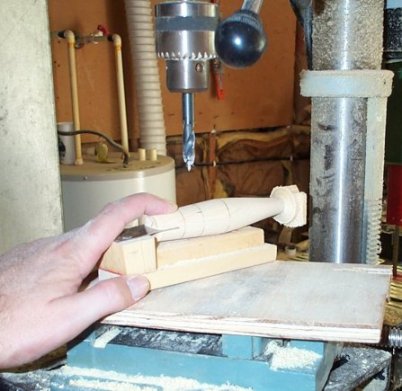 After the holes are drilled, you can remove the square end from the tail. A final sanding with 180 grit and we are ready for sealing/priming/painting. Note that epoxy will have trouble sticking to sharp edges, so I like to round the ends a bit. 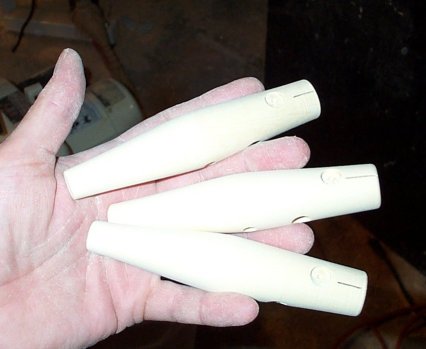 I stick a section of wire into the tail so I have something to hold while painting etc. The wire is crimped on the end inserted in the plug and bent over at the other end to allow for hanging the plug while drying. Now its time to seal the plug. I use a mix of boiled linseed oil and mineral spirits (60% linseed, 40% spirits). I use a section of PVC pipe with ends on and a clamp to hold it the mix up right. Dip the plug for 30 seconds, let the excess drip off, then wipe the plug with a rag and hang to dry (be sure to read the warnings on the linseed label for proper disposal of the rags - there CAN be a FIRE Hazzard). After the sealer has dried, you can epoxy the weight in the plug. I have a mold set up to make my own, but you can use egg sinkers, buckshot, etc. Njtackle.com also sells some slugs for plug making too. 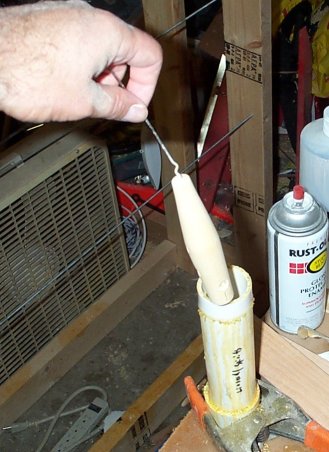 Next, prime, then paint in your favorite schemes. A suggestion of something to try here: paint the plug black, then fog the belly with Createx Chamilion blue. Hit a shot of red on the chin to complete it. The plug goes from metallic blue on the belly to black on the back. Simple, but looks pretty cool! The chamilion lilac also looks pretty good over the black too After the paint has dried for at least 24 hours, I’ll add the eyes, red in this case. Add a touch of epoxy in the eyehole, then insert the eye. I do this even on the eyes with adhesive backing. Helps keep them in place when they get knocked about. 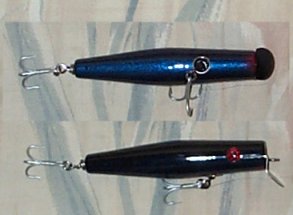 You can add the lip and grommet before, or after clear coating. To get the grommet to match the curve of the plug, I use a section of a dowel close to the diameter of the plug with a hole in the center (same diameter as the grommet hole on the plug). Another piece of scrap wood is cut to match this. Place a grommet in the hole, hold the other wood on the head of the grommet and hit with a hammer. The edges of the grommet are now curved to match the plug. 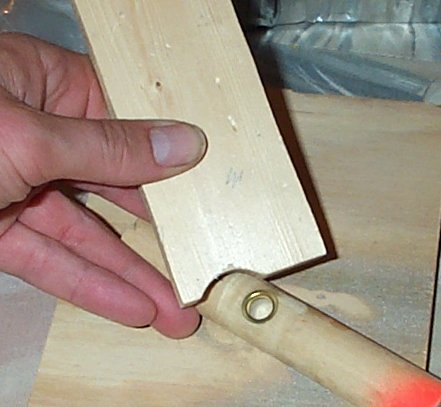 As I am doing this plug in black, I have also painted the grommet and lip black too. Rustoleum spray paint can be used for this. On this plug, I use 4H rings and 1/0, 4x VMC’s. And the finished plug:  A couple of notes. I use my stuff in freshwater. For saltwater, additional weight or larger hooks may also be used. Also, I like my plugs with a front treble and a treble on the tail. The plug could also be made with an additional treble on the body or a siwash on the tail. You may have to mess with the weight a little if you go this route. When slow waked on top, the plug will have a nice wiggle with some roll. If you want less roll, you can grind the edges of the lip some so that the sides of the lip are straight rather than rounded. The tail width can also be modified to change the action some too. Same for wood type that you use. Try several and see what works best for you. To make a larger sized version, just increase the dimensions to the size that you want. The width at the front should be the same as the width of the lip you use. The version I’ve shown is one I’ve been working on for a while and it works how I want. You can use the above as a starting point and experiment to get the action you want from your plug. Be sure to post photos of the ones you come up with. Don’t worry, I don’t mind people copying this one for their own use... Happy turning, Jigman The Full Thread is Listed Here on the Striper Forums: http://www.striped-bass.com/Stripertalk/showthread.php?t=20279 |


